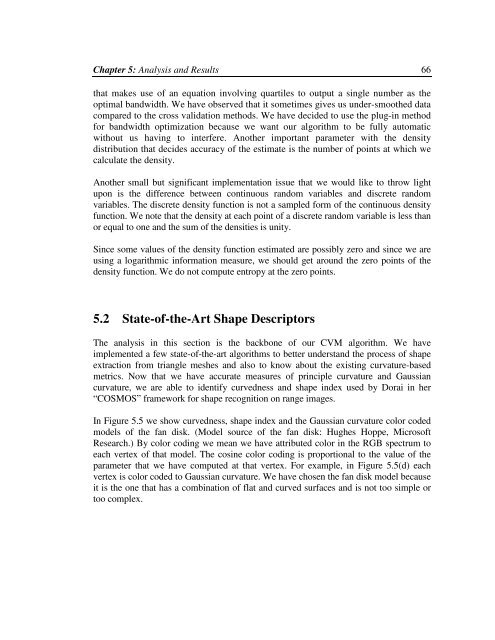To the Graduate Council: I am submitting herewith a thesis written by ...
To the Graduate Council: I am submitting herewith a thesis written by ...
To the Graduate Council: I am submitting herewith a thesis written by ...
Create successful ePaper yourself
Turn your PDF publications into a flip-book with our unique Google optimized e-Paper software.
Chapter 5: Analysis and Results 66that makes use of an equation involving quartiles to output a single number as <strong>the</strong>optimal bandwidth. We have observed that it sometimes gives us under-smoo<strong>the</strong>d datacompared to <strong>the</strong> cross validation methods. We have decided to use <strong>the</strong> plug-in methodfor bandwidth optimization because we want our algorithm to be fully automaticwithout us having to interfere. Ano<strong>the</strong>r important par<strong>am</strong>eter with <strong>the</strong> densitydistribution that decides accuracy of <strong>the</strong> estimate is <strong>the</strong> number of points at which wecalculate <strong>the</strong> density.Ano<strong>the</strong>r small but significant implementation issue that we would like to throw lightupon is <strong>the</strong> difference between continuous random variables and discrete randomvariables. The discrete density function is not a s<strong>am</strong>pled form of <strong>the</strong> continuous densityfunction. We note that <strong>the</strong> density at each point of a discrete random variable is less thanor equal to one and <strong>the</strong> sum of <strong>the</strong> densities is unity.Since some values of <strong>the</strong> density function estimated are possibly zero and since we areusing a logarithmic information measure, we should get around <strong>the</strong> zero points of <strong>the</strong>density function. We do not compute entropy at <strong>the</strong> zero points.5.2 State-of-<strong>the</strong>-Art Shape DescriptorsThe analysis in this section is <strong>the</strong> backbone of our CVM algorithm. We haveimplemented a few state-of-<strong>the</strong>-art algorithms to better understand <strong>the</strong> process of shapeextraction from triangle meshes and also to know about <strong>the</strong> existing curvature-basedmetrics. Now that we have accurate measures of principle curvature and Gaussiancurvature, we are able to identify curvedness and shape index used <strong>by</strong> Dorai in her“COSMOS” fr<strong>am</strong>ework for shape recognition on range images.In Figure 5.5 we show curvedness, shape index and <strong>the</strong> Gaussian curvature color codedmodels of <strong>the</strong> fan disk. (Model source of <strong>the</strong> fan disk: Hughes Hoppe, MicrosoftResearch.) By color coding we mean we have attributed color in <strong>the</strong> RGB spectrum toeach vertex of that model. The cosine color coding is proportional to <strong>the</strong> value of <strong>the</strong>par<strong>am</strong>eter that we have computed at that vertex. For ex<strong>am</strong>ple, in Figure 5.5(d) eachvertex is color coded to Gaussian curvature. We have chosen <strong>the</strong> fan disk model becauseit is <strong>the</strong> one that has a combination of flat and curved surfaces and is not too simple ortoo complex.
















